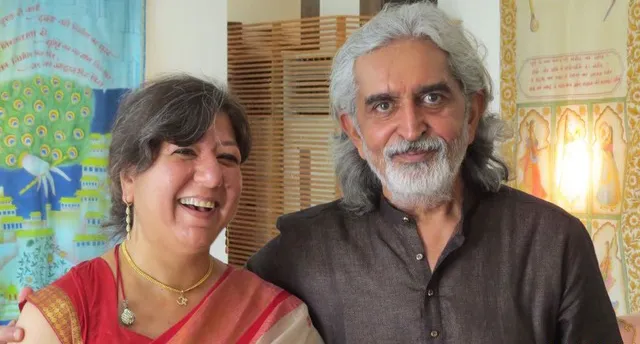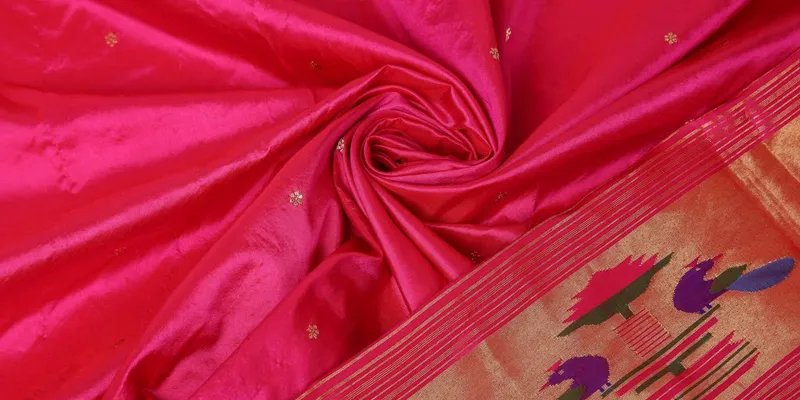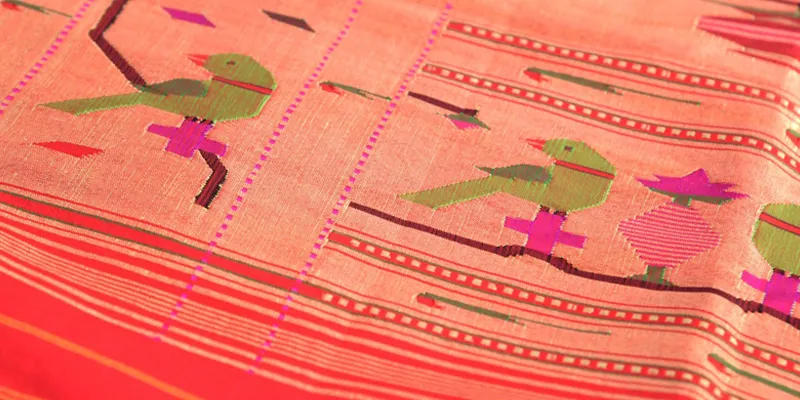‘My love for the textile inspires me’ – Saree curator and co-founder of Artisan Saga on the beauty of handlooms
Seema Agrawal, co-founder and Design Head of Artisan Saga speaks about handlooms, Paithani sarees, weavers and her love for indigenous textiles
If the kaleidoscopic colours of the Paithani sarees are not fascinating enough, then the hand-woven beauty of the weaves makes it the queen of heirlooms. Paithani sarees, named after the Paithan town in Aurangabad district in Maharashtra, are characterised by unique borders and a pallu that is heavy with design and large motifs.
Artisan Saga, a Gurugram- based design house that presented their latest collection at Mithila in Bengaluru brought classic Paithani sarees to the city besides a range of other handlooms. The founders of Artisan Saga, Seema Agrawal and Kaushik Rajani also showcased a collection of miniature art-inspired hand-painted sarees with influences from Pichwai Art.
YS Weekender caught up Seema Agrawal, co-founder and Design Head of Artisan Saga to speak about why it is important to discover the beauty of handlooms in our country.

Seema Agrawal and Kaushik Rajani
“My association with handlooms began with a road trip,” says Seema. “We went on a tour by road through MP, Gujarat, Maharashtra and Rajasthan and visited all the small towns and villages on the way. We took a whole month to meet various artisans and weavers. It was a fascinating trip.”
When Seema and Kaushik returned from their journey, they decided to enter the arena of handloom sarees. Today, Artisan Saga is an online haven for lovers of art and beauty, where form, colour and texture of beautiful weaves are brought to life by creative craftsmen. They handpick the best designed sarees and curate a variety of handloom sarees.
“Our interactive communication with the local craftsman helps us to understand in depth, the effort behind his or her creation,” explains Seema.

Paithani sarees showcase the skill of the weavers
“Many weavers struggle to make their ends meet and fight for survival. In fact, the whole family of the weaver gets engaged in the weaving of a handloom saree, taking turns to weave so as to increase their output and earn more money.”
According to Seema, most weavers have their own creative inputs to offer in the making of hand-woven sarees, a skill that is usually inherited from their forefathers. Their collaborative efforts are now providing them the means to sustain handloom weaving and encourage the younger generation to not only adopt the family skill, but to take it forward by developing complex designs with the use of computers.
So when you drape a handwoven saree, remember, it is not just six yards of fabric that you drape, but you embody somebody’s thought process, somebody’s creative skill, and you also help a weaver’s family to survive and a tradition to live on.
“When I watched the weavers at work during our travels I was so proud to be a part of the country,” she says. “There is such marvellous craftsmanship involved. The weavers respect their work and are passionate about it. Even the way they handle their sarees is so reverent – it is like unfolding a work of art. It feels like there is a soul in the saree and it can be felt.”
Seema is an alumnus of the Inchbald School of Design, London and she handles the choice of design and the creative work while Kaushik handles the business aspect of the enterprise.

A lot of patience, talent and teamwork goes into each handloom saree
“I feel that the handlooms of India are so beautiful that more people should be aware of all that is available in our country. There should be trips organised to show people the weaving process and what goes into it. People will begin to appreciate the amount of patience, talent and teamwork that goes into each handloom saree,” she adds.
She also has some tips to offer to women while buying a handloom saree. “If you are short or curvier, then it is best to stay away from sarees with big borders. Go for the narrow ones. Those who are tall and slim should opt for sarees with bigger motifs. Your blouse should be stitched with elbow-length sleeves because the whole border of these sarees falls onto the elbow."
She believes that the beauty of an Indian garment lies in the fact is that it suits all women without exception whereas western garments suit only a few women perfectly.
Today, a number of young people are also taking interest in sarees due to the various movements on social media where girls tells their friends the stories behind their sarees. Seema believes this is a great way to popularise Indian garments.
With Artisan Saga, she hopes to take the beauty of handlooms to more and more people. “It is the love for the art and the love for the textile that inspires me,” she says.







